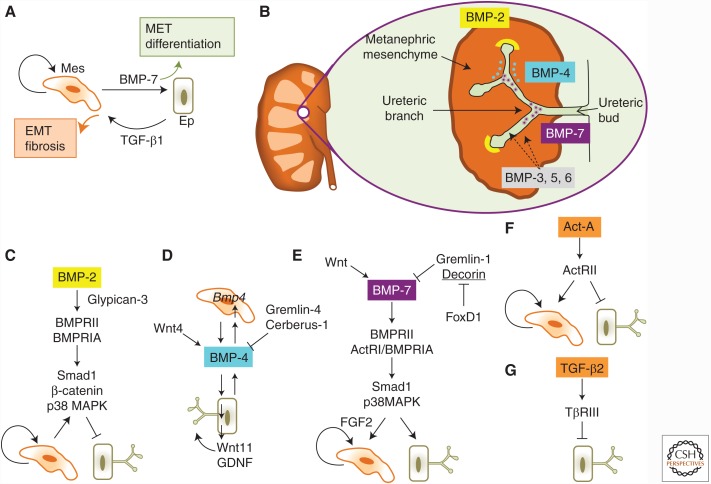Figure 4.
Role of the TGF-β family in kidney organogenesis. (A) Overall logic of bone morphogenetic protein (BMP) and TGF-β signaling effects in the kidney. A metanephric mesenchymal cell (Mes) is shown to differentiate into an epithelial cell (Ep) of the branching ureteric bud. BMP-7 promotes differentiation and causes MET. Mesenchymal cells proliferate (self-targeting arrow). Under pathologic conditions TGF-β1 induces EMT, promotes the mesenchymal phenotype, and tissue fibrosis. (B) A snapshot of early steps during branching morphogenesis in the kidney. A developed kidney on the left and a primitive ureteric bud with its developing branches and the surrounding metanephric mesenchyme. Localization of BMP ligands is shown in the mesenchyme (orange) or lumen of the developing ureteric epithelium (green). Three BMPs, BMP-2 (yellow cup), BMP-4 (blue dots), and BMP-7 (purple stars), are highlighted because they are extensively discussed in this review. BMP-3, -5, and -6 are also expressed either in the mesenchyme or the epithelium (dotted arrows) but they are not discussed in this review because of the lack of substantial functional analyses in the kidney. (C) BMP-2 signaling inhibits branching morphogenesis and promotes mesenchymal proliferation. The coreceptor glypican-3 assists BMP-2 signaling through BMPRII and BMPRIA, which activate Smad1, β-catenin, and p38 mitogen activated protein kinase (MAPK) in the epithelial cells. (D) BMP-4 signaling promotes branching morphogenesis. BMP-4 is expressed through epithelial ectodermal cells and acts on mesenchymal cells, which then secrete their own BMP-4 (shown as the Bmp4 gene in the cell nucleus) that acts on the epithelial cells and promotes branching of the growing epithelium through transcriptional induction and secretion of Wnt11 and glial cell-derived neurotrophic factor (GDNF). Wnt4 is an upstream inducer of BMP-4 expression, whereas the extracellular antagonists Gremlin-4 and Cerberus-1 limit the activity of BMP-4. (E) BMP-7 signaling promotes branching morphogenesis and mesenchymal proliferation. Wnt signaling transcriptionally induces BMP-7 expression, whereas the extracellular antagonists Gremlin-1 and Decorin limit the activity of BMP-7. Decorin (underlined), but not Gremlin-1, expression is transcriptionally repressed by FoxD1. BMP-7 signals through BMPRII, ActRI and BMPRIA, which activate Smad1 and p38 MAPK signaling, to promote branching of the growing epithelium or mesenchymal proliferation. (F) Activin A inhibits branching morphogenesis and promotes mesenchymal cell proliferation. Activin A signaling through activin type II receptor (ActRII) inhibits branching of the growing epithelium and promotes mesenchymal proliferation. (G) TGF-β2 inhibits branching morphogenesis. TGF-β2 signaling by the coreceptor TβRIII/ betaglycan and the receptors TβRII and TβRI (not shown) inhibits branching of the growing epithelium.

